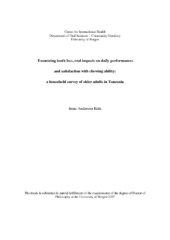| dc.description.abstract | Objective: The main objective of this study was to assess the prevalence, extent and risk indicators of tooth loss, and how it impacts on the quality of life of older adults living in rural and urban areas of Tanzania. Methods: A cross sectional survey of older adults aged 50 years and above, residing in the two districts of Pwani region and one district of Dar es Salaam city, was conducted from November 2004 to June 2005. A stratified (disproportionate) two stage cluster sample design with villages as the primary sampling unit was utilized (N = 1200). Participants from the selected villages were clinically examined for decayed teeth and missing teeth due to caries / other reasons than caries, according to the criteria described by the World Health Organization (third molars included). Tooth mobility was assessed using Millers’ index; and oral health and hygiene using Mucosal- Plaque score. Functional premolar and molar occluding units were counted based on existing natural tooth contacts between maxilla and mandible in the bilateral regions, and anterior occluding units, (i.e. pairs of opposing canines and incisors that support occlusion) were identified from clinical photographs taken under field conditions. Interview schedules were conducted using structured questionnaires, which included socio-demographic details, perceived chewing ability, satisfaction / dissatisfaction with chewing ability and Kiswahili version of the Oral Impacts on Daily Performances (OIDP) and also questions regarding their perceived general and oral health conditions. Data were analyzed using Statistical Package for Social Scientists, SPSS versions 13 and 14. Cross tabulation and Chi-square statistics were used to assess bivariate relationships. Prevalence of tooth loss and risk indicators for tooth loss, reduced premolar/molar support, dissatisfaction with chewing ability and having any oral impacts (OIDP >0), were estimated by stepwise logistic regression, with 95% confidence interval (CI) given for the odds ratios indicating statistically significant relationship if both values were above or below 1. Psychometric properties of the Kiswahili version of OIDP were assessed using Mann-Whitney U test and Kruskal-Wallis test. Weighted prevalence of OIDP was also assessed. To adjust for the effect of the cluster design, reanalyses were conducted with STATA 9.0 and 9.2 using the svylogit command. Results: The mean DMFT of older adults was 6.7 SD=6.4 and 5.6 SD=5.6, for the urban and rural subjects, respectively. Over eighty three percent had experienced at least one tooth lost due to any reason, due to caries 61.7% and due to other reason than caries, 29.2%. The mean tooth loss was 6.1 SD=6.4 and 5.9 SD=6.6 among older adults in the urban and rural areas, respectively. Predictors of prevalence of tooth loss due to caries associated with being a female, living in urban areas, having 2 or more decayed teeth and attending a dental clinic mainly when having problems. While prevalence of losing teeth due to other reasons than caries associated with being male and over 60 years of age, being most poor, having mobile teeth, not attending a dental clinic and confirming use of tobacco. In total, 38.8% reported problems with chewing at least one food item and 23.3% were dissatisfied with their chewing ability. Those with reduced anterior and posterior occluding units were more likely to report problems with chewing any food. Subjects dissatisfied with their chewing ability were less likely to be females (OR=0.6) and more likely to have reduced anterior/posterior occluding units (OR=3.4), to report dental pain (OR=2.5), chewing problems (OR=4.7) and OIDP (OR=3.2). The OIDP scores discriminated between satisfied and dissatisfied groups irrespective of confirmed chewing problems. The Kiswahili version of OIDP demonstrated good construct and criterion validity. The OIDP inventory varied systematically in the expected direction with the reported perceived oral health status and perceived chewing ability. The weighted prevalence of oral impacts of older adults in urban and rural areas was 51.2% and 62.1%, respectively. The most prevalent impact was eating and perceived causes of impacts being mostly tooth ache. The impacts were prevalent among the rural than urban older adults. Conclusion: The study showed that, caries was the principle cause of tooth loss and molar teeth were the teeth most commonly lost. Tooth loss due to caries and due to reasons other than caries was differently related to disease- and socio- behavioral risk factors. Community dwelling older adults had prevalent chewing problems and dissatisfaction with chewing ability. Oral impacts affecting their performances, using a Kiswahili version OIDP inventory, were relatively common but not very severe. Clinical measures of dentition status together with reported functional- and psychosocial impact scores determined subjects’ evaluation of their chewing ability and should be taken into account when estimating treatment needs. | en_US |
